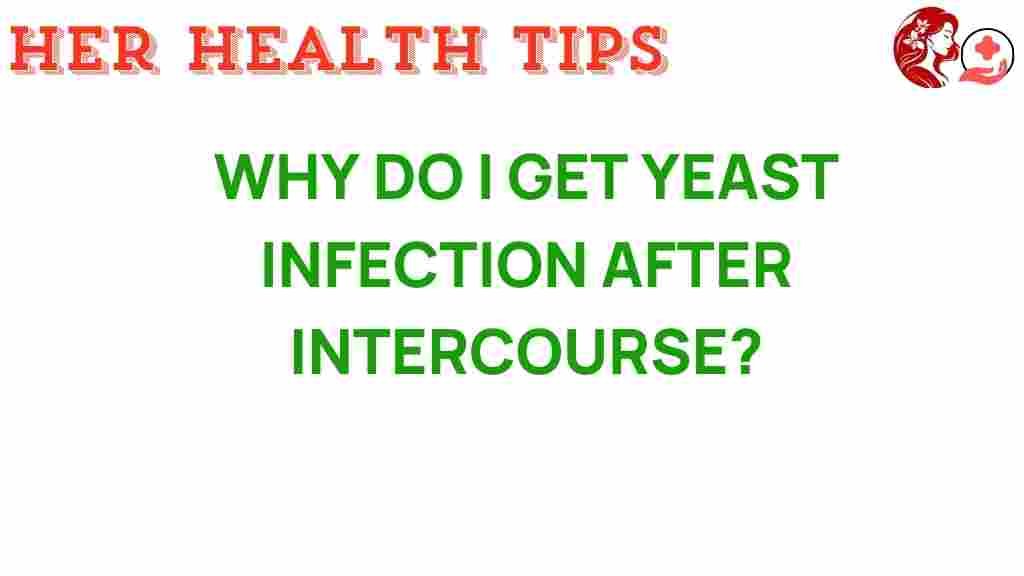Unraveling the Mystery: Why Do Yeast Infections Occur After Intercourse?
Yeast infections are a common issue that many women face, and they can often occur after intercourse. Understanding why these infections happen and how to manage them is crucial for maintaining women’s health and intimate wellness. This article aims to explore the relationship between yeast infections and intercourse, the underlying causes, symptoms, prevention strategies, and treatment options.
Understanding Yeast Infections
Yeast infections are caused by an overgrowth of the fungus Candida, which is normally present in small amounts in the vagina. When the balance of the vaginal microbiome is disrupted, this fungus can multiply, leading to uncomfortable symptoms.
Common Symptoms of Yeast Infections
Women experiencing a yeast infection may notice the following symptoms:
- Itching and irritation in the vaginal area
- Thick, white vaginal discharge resembling cottage cheese
- Redness and swelling of the vulva
- Pain during intercourse
- Burning sensation during urination
Why Do Yeast Infections Occur After Intercourse?
There are several factors that can contribute to the development of a yeast infection following intercourse. Understanding these factors is essential to help prevent future infections.
1. Changes in the Vaginal Microbiome
Intercourse can introduce new bacteria and alter the existing balance of the vaginal microbiome. This disruption can create an environment favorable for yeast overgrowth. Factors that play a role in this include:
- Natural bodily fluids that may have a different pH
- Lubricants or condoms that can irritate the vaginal area
- Partner’s microbiome, particularly if they have an imbalance themselves
2. Hormonal Fluctuations
Hormones play a crucial role in maintaining vaginal health. Fluctuations due to menstrual cycles, pregnancy, or hormonal contraceptives can affect the vaginal environment. After intercourse, these hormonal changes may become more pronounced, triggering a yeast infection.
3. Antibiotic Use
Antibiotics are often prescribed to treat bacterial infections, but they can also disrupt the natural balance of bacteria in the vagina, leading to an overgrowth of yeast. If you have recently taken antibiotics, it’s important to be aware of the increased risk of a yeast infection.
4. Moisture and Heat
Intercourse can create a warm and moist environment in the vaginal area, which is ideal for yeast proliferation. If proper hygiene is not maintained, this can lead to an increased risk of infection.
Prevention Strategies for Yeast Infections
Preventing yeast infections, especially those triggered by intercourse, involves maintaining a healthy vaginal environment. Here are some effective prevention strategies:
1. Practice Good Hygiene
Post-intercourse hygiene is essential. Consider the following tips:
- Urinate after intercourse to help flush out any bacteria introduced during the act.
- Gently cleanse the vaginal area with water and mild soap.
- Avoid douching or using scented products that can irritate the vaginal area.
2. Choose Appropriate Lubricants
If you use lubricants during intercourse, opt for water-based or silicone-based products. Avoid those with added fragrances or irritants that can disrupt the natural balance.
3. Wear Breathable Clothing
Choose loose-fitting, breathable underwear made from natural fibers like cotton. This helps to keep the genital area dry and reduces moisture buildup.
4. Monitor Your Diet
A balanced diet can influence the health of your microbiome. Consider reducing your intake of:
- Sugars and refined carbohydrates
- Processed foods
Incorporating probiotics can also support a healthy microbiome. Foods like yogurt and kefir are great options.
Treatment Options for Yeast Infections
If you suspect you have a yeast infection, it’s essential to seek treatment promptly. Here are some common treatment options:
1. Over-the-Counter Antifungal Medications
Many effective antifungal treatments are available over-the-counter, including:
- Clotrimazole (Lotrimin)
- Miconazole (Monistat)
- Tioconazole (Vagistat)
These treatments come in various forms, such as creams, ointments, and suppositories.
2. Prescription Medications
If over-the-counter options are ineffective, your healthcare provider may prescribe stronger antifungal medications, such as:
- Fluconazole (Diflucan)
3. Home Remedies
Some women find relief with home remedies, although these should not replace medical treatment. Options include:
- Apple cider vinegar baths
- Plain yogurt applied topically or ingested
Always consult your healthcare provider before trying home remedies, especially if you have recurrent infections.
Troubleshooting Tips for Yeast Infections
If you find yourself frequently dealing with yeast infections post-intercourse, consider the following troubleshooting tips:
1. Keep a Symptom Diary
Recording your symptoms and their timing can help identify triggers or patterns related to your yeast infections. Note when they occur in relation to your menstrual cycle, diet, and sexual activity.
2. Communicate with Your Partner
Discuss any concerns with your partner. Sharing information about health, hygiene, and any potential symptoms can help both of you maintain intimate wellness.
3. Consult a Healthcare Provider
Recurrent yeast infections may indicate an underlying health issue. A healthcare provider can assess your situation and recommend appropriate testing or treatment.
4. Explore Probiotic Options
Probiotics can help restore the balance of healthy bacteria in the vagina. Consider adding a probiotic supplement or probiotic-rich foods to your diet.
Conclusion
Understanding the connection between yeast infections and intercourse is crucial for maintaining women’s health and intimate wellness. By recognizing the symptoms, identifying potential causes, and implementing effective prevention strategies, you can significantly reduce the risk of experiencing these uncomfortable infections. If you do find yourself dealing with a yeast infection, know that there are various treatment options available to help restore balance and comfort.
For more information about women’s health, visit womenshealth.gov. For further reading on maintaining a healthy microbiome, check out this resource.
This article is in the category Reproductive and created by HerHealthTips Team
